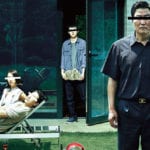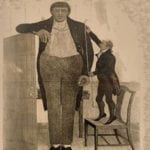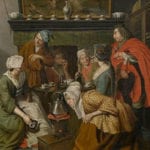Influenced: EMI It’s slightly odd starting with the Beatles last album, but it’s also a slightly odd influence; Abbey Road studios is named after the Abbey Road album, not the other way around. When the Beatles recorded there, it was the EMI London Recording Studio. The name was changed (and a zebra crossing logo developed) after the album was released, Abbey Road suddenly became the most famous recording studio in the world. Staff members became celebrities when people found out they worked there.
Influenced: Jeff Lynne and ELO The first song to be recorded after the Beatles stopped touring and approached with the attitude that they were going to get it right – there was to be no compromise. The final recording is actually two different versions of the song edited together; thanks to heroic efforts by George Martin. Lennon was still dissatisfied – but he didn’t like most of his recordings. The influence of this song was actually a few years later. In 1971, Jeff Lynne formed the Electric Light Orchestra with the intention of picking up from Strawberry Fields Forever; mixing traditional rock band instruments with classical instruments.
Influenced: Mick Jagger and Keith Richards As Paul has openly admitted, this was not one of their better songs. It was given to Ringo as his contribution to With The Beatles. However, its biggest influence was when Mick Jagger told Lennon & McCartney they needed a follow-up to their first hit single. At that time, the Rolling Stones were a cover band – they didn’t write their own material. Legend has it that John & Paul disappeared for 15 minutes and returned with I Wanna be Your Man. It made Jagger and Keith Richards realise that writing their own songs was possible.
Influenced: Brian Wilson Brian Wilson was “knocked out” by the Beatles album Rubber Soul; as he put it – each track “was a gas”. As a response he produced Pet Sounds. It was as a response to Pet Sounds that the Beatles produced Sgt Pepper. Paul McCartney has acknowledged that there was a definite feeling of competition between The Beatles and the Beach Boys. The clip is Norwegian Wood – my favorite track from the album. George Martin recalled that when they listened to Pet Sounds, the Beatles asked “Can we do something as good as this?” Martin replied, “No. We can do better.”
Influenced: The Beatles and the USA I Wanna Hold Your Hand changed the life of the Beatles; it was their first number one in America. As George Martin has pointed out, they had tremendous difficulties getting records released in the USA. EMI actually owned Columbia Records, and Columbia still wouldn’t release Beatle singles – the early singles were released on tiny labels (Swann comes to mind) in the USA. It was partly the successful sales of these singles that forced Columbia to release Beatle singles. I Wanna Hold Your Hand was a huge hit in the USA just as the Beatles arrived for their first US tour. Their timing, as ever, was perfect.
Influenced: EMI Staff at Abbey Road This was a performance that amazed EMI staff. People working on the Beatles session have memories of playing the tape to staff members the next day and saying “Wait until you hear this!” Within EMI, it was realized that something special was happening. George Harrison recalled attitudes changing towards the band between their first visits to Abbey Road (to record their first singles) and after they’d had a hit – and recorded Twist and Shout. Twist and Shout was recorded at the end of a single day in which the entire first LP (album in American) was recorded. EMI would only give them a day’s studio time, it was winter and the band had colds – Lennon’s was particularly bad. What makes Twist and Shout all the more remarkable is that it was recorded in one take and as a “live” recording – there was no overdubbing possible in those days. George Martin did record a second take, but Lennon’s voice had gone so it was the first take that was used.
Influenced: Pop Musicians Everywhere Tomorrow Never Knows was the first Beatles track to use artificial double tracking (ADT). In fact, it was almost certainly the first track anywhere to deliberately use the effect. Double tracked vocals (where the singer sings the same part twice) became popular when 4 track recording arrived – quite late at Abbey Road, around 1964. Lennon, in particular, didn’t like singing the same thing twice – it was obviously important that exactly the same words and phrasing were used, making such sessions tedious and tiring. With this in mind, Ken Townsend – EMI engineer “had an idea” driving home after such a session. The singer would sing the part once, and then a copy made and played along side the original with a slight, varying delay – the affect was double tracked vocals without having to sing the part twice. Lennon loved the effect but not being in the least bit technical, had no chance of understanding the technique involved. George Martin gave him a pseudoscientific explanation (“There’s feedback on the sploshing flange”) and after that, Lennon started calling the affect “Ken’s Flanger” and said in interview that “Every track on Sgt Pepper had flanging, it’s great!” To this day, the effect is called flanging – some people claim that it is named after pressing the flange wheel on a reel to reel tape deck, but if you tried that on a professional tape deck, you’d lose a finger!
Influenced: George Martin and Dick James After recording Please, Please Me, Martin was able to tell the Beatles, “Congratulations Gentlemen, you have recorded your first number one”. A big moment for the Beatles, but also for George Martin himself. George Martin was known as a producer of comedy and novelty records. His highest placed record, before Please, Please Me was Love Me Do – but that only reached number 17. Before that his only “hit” had been the Robin Hood theme tune, sung by Dick James. So, when Please, Please Me was being recorded Martin was the most junior producer in EMI (he was the youngest, and Parlophone, Martin’s label, was the smallest). A year later, he was one of the most famous producers in the world. The aforementioned Dick James became a music publisher when baldness ended his singing career. He had given a song (How Do You Do It?) to George Martin for the Beatles, which the Beatles hated. The Beatles offered up Please, Please Me instead. George Martin, to his credit, let them record their own song. Dick James recalled getting a phone call from Martin which started “You know that song the Beatles were going to release?” There is a happy ending for Dick James, he offered to publish Please, Please Me and became the Beatles song publisher – forming Northern Songs especially for the band.
Influenced: George Harrison – and more or less everyone Raunchy was never released by the Beatles but it was George Harrison’s audition piece which got him into the Beatles and performed at Paul’s prompting to John on top of a Liverpool bus. According to Paul, George’s guitar work was “perfect”. George was three years younger than John; you can imagine John’s attitude (being nearly 18) to a 14 year old wanting to join the band. George must have been pretty good!
Influenced: John, Paul, George and Ringo and pretty much everyone since. Never recorded by the Beatles, this was the song that Paul played to John when they first met at a garden fête where John was performing with his band (The Quarrymen). John was so impressed he asked Paul to join the band the next day: he delayed because he was trying to reconcile strengthening the band with the weakening of his own position as band leader and the fact that Paul was two years his junior. Finally, he decided that the improvement to the band was most important. In fairness, the surviving members of the Quarrymen can’t remember what Paul sang – John couldn’t remember as he was somewhat drunk at the time (despite being 4 years under age). However, if the story is true, Paul performing Twenty Flight Rock might be the most influential performance in pop history.














